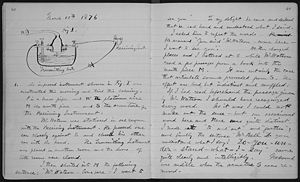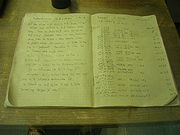
Lab notebook
Encyclopedia
A lab notebook is a primary record of research
. Researchers use a lab notebook to document their hypotheses
, experiment
s and initial analysis or interpretation of these experiments. The notebook serves as an organizational tool, a memory aid, and can also have a role in protecting any intellectual property
that comes from the research.


 The guidelines for lab notebooks vary widely between institution and between individual labs, but some guidelines are fairly common, for example, like those in the reference. The lab notebook is typically permanently bound and pages are numbered. Dates are given as a rule. All entries are with a permanent marker, e.g., a ballpoint pen. The lab notebook is usually written as the experiments progress, rather than at a later date. In many laboratories, it is the original place of record of data (no copying is carried out from other notes) as well as any observations or insights. For data recorded by other means (e.g., on a computer), the lab notebook will record that the data was obtained and the identification of the data set will be given in the notebook. Many adhere to the concept that a lab notebook should be thought of as a diary of activities that are described in sufficient detail to allow another scientist to replicate the steps. In laboratories with several staff and a common laboratory notebook, entries in the notebook are signed by those making them.
The guidelines for lab notebooks vary widely between institution and between individual labs, but some guidelines are fairly common, for example, like those in the reference. The lab notebook is typically permanently bound and pages are numbered. Dates are given as a rule. All entries are with a permanent marker, e.g., a ballpoint pen. The lab notebook is usually written as the experiments progress, rather than at a later date. In many laboratories, it is the original place of record of data (no copying is carried out from other notes) as well as any observations or insights. For data recorded by other means (e.g., on a computer), the lab notebook will record that the data was obtained and the identification of the data set will be given in the notebook. Many adhere to the concept that a lab notebook should be thought of as a diary of activities that are described in sufficient detail to allow another scientist to replicate the steps. In laboratories with several staff and a common laboratory notebook, entries in the notebook are signed by those making them.
s. This format has gained some popularity, especially in large pharmaceutical companies, which have large numbers of researchers and great need to document their experiments.
, after the title of a 2006 blogpost by chemist Jean-Claude Bradley. The term is frequently used to distinguish this aspect of Open Science from the related but rather independent developments commonly labeled as Open Source
, Open Access, Open Data
and so forth. The openness of the notebook, then, specifically refers to the set of the following points, or elements thereof:
The use of a wiki
makes it convenient to track contributions by individual authors.
Research
Research can be defined as the scientific search for knowledge, or as any systematic investigation, to establish novel facts, solve new or existing problems, prove new ideas, or develop new theories, usually using a scientific method...
. Researchers use a lab notebook to document their hypotheses
Hypothesis
A hypothesis is a proposed explanation for a phenomenon. The term derives from the Greek, ὑποτιθέναι – hypotithenai meaning "to put under" or "to suppose". For a hypothesis to be put forward as a scientific hypothesis, the scientific method requires that one can test it...
, experiment
Experiment
An experiment is a methodical procedure carried out with the goal of verifying, falsifying, or establishing the validity of a hypothesis. Experiments vary greatly in their goal and scale, but always rely on repeatable procedure and logical analysis of the results...
s and initial analysis or interpretation of these experiments. The notebook serves as an organizational tool, a memory aid, and can also have a role in protecting any intellectual property
Intellectual property
Intellectual property is a term referring to a number of distinct types of creations of the mind for which a set of exclusive rights are recognized—and the corresponding fields of law...
that comes from the research.
Structure



Legal aspects
To ensure that data cannot be easily altered, notebooks with permanently bound pages are often recommended. Researchers are often encouraged to write only with unerasable pen, to sign and date each page, and to have their notebooks inspected periodically by another scientist who can read and understand it. All of these guidelines can be useful in proving exactly when a discovery was made, in the case of a patent dispute.Electronic formats
Several companies now offer electronic lab notebookElectronic lab notebook
An electronic lab notebook is a software program designed to replace paper laboratory notebooks. Lab notebooks in general are used by scientists and technicians to document research, experiments and procedures performed in a laboratory...
s. This format has gained some popularity, especially in large pharmaceutical companies, which have large numbers of researchers and great need to document their experiments.
Open lab notebooks
In recent years, lab notebooks kept online have started to become as transparent to the world as they are to the researcher keeping them, a trend often referred to as Open Notebook ScienceOpen Notebook Science
Open Notebook Science is the practice of making the entire primary record of a research project publicly available online as it is recorded. This involves placing the personal, or laboratory, notebook of the researcher online along with all raw and processed data, and any associated material, as...
, after the title of a 2006 blogpost by chemist Jean-Claude Bradley. The term is frequently used to distinguish this aspect of Open Science from the related but rather independent developments commonly labeled as Open Source
Open source
The term open source describes practices in production and development that promote access to the end product's source materials. Some consider open source a philosophy, others consider it a pragmatic methodology...
, Open Access, Open Data
Open Data
Open data is the idea that certain data should be freely available to everyone to use and republish as they wish, without restrictions from copyright, patents or other mechanisms of control. The goals of the open data movement are similar to those of other "Open" movements such as open source, open...
and so forth. The openness of the notebook, then, specifically refers to the set of the following points, or elements thereof:
- Sharing of the researcher's laboratory notebook online in real time without password protection or limitations on the use of the data.
- The raw dataRaw data'\putang inaIn computing, it may have the following attributes: possibly containing errors, not validated; in sfferent formats; uncoded or unformatted; and suspect, requiring confirmation or citation. For example, a data input sheet might contain dates as raw data in many forms: "31st January...
used by the researcher to derive observations and conclusions are made available online to anyone. - All experimental data are shared, including failed or ambiguous attempts.
- Feedback and other contributions to the research effort can be integrated easily with the understanding that everything is donated to the public domainPublic domainWorks are in the public domain if the intellectual property rights have expired, if the intellectual property rights are forfeited, or if they are not covered by intellectual property rights at all...
.
The use of a wiki
Wiki
A wiki is a website that allows the creation and editing of any number of interlinked web pages via a web browser using a simplified markup language or a WYSIWYG text editor. Wikis are typically powered by wiki software and are often used collaboratively by multiple users. Examples include...
makes it convenient to track contributions by individual authors.
See also
- Composition bookComposition bookA composition book is one of a type of stock-bound notebook commonly used by writers and students. Although available in several colors, the original marbled black-and-white cover, with its generic label on the front, is the overwhelming favorite....
- Electronic lab notebookElectronic lab notebookAn electronic lab notebook is a software program designed to replace paper laboratory notebooks. Lab notebooks in general are used by scientists and technicians to document research, experiments and procedures performed in a laboratory...
- Invention disclosureInvention disclosureAn invention disclosure, or invention disclosure report, is a confidential document written by a scientist or engineer for use by a company's patent department, or by an external patent attorney, to determine whether patent protection should be sought for the described invention. It may follow a...
- Inventor's notebookInventor's notebookAn inventor's notebook is used by inventors, scientists and engineers to record their ideas, invention process, experimental tests and results and observations. It is not a legal document but is valuable, if properly organized and maintained, since it can help establish dates of conception and...
- Laboratory information management systemLaboratory Information Management SystemSometimes known as a laboratory information system or laboratory management system , a laboratory information management system is a software-based laboratory and information management system that offers a set of key features that support a modern laboratory's operations...

